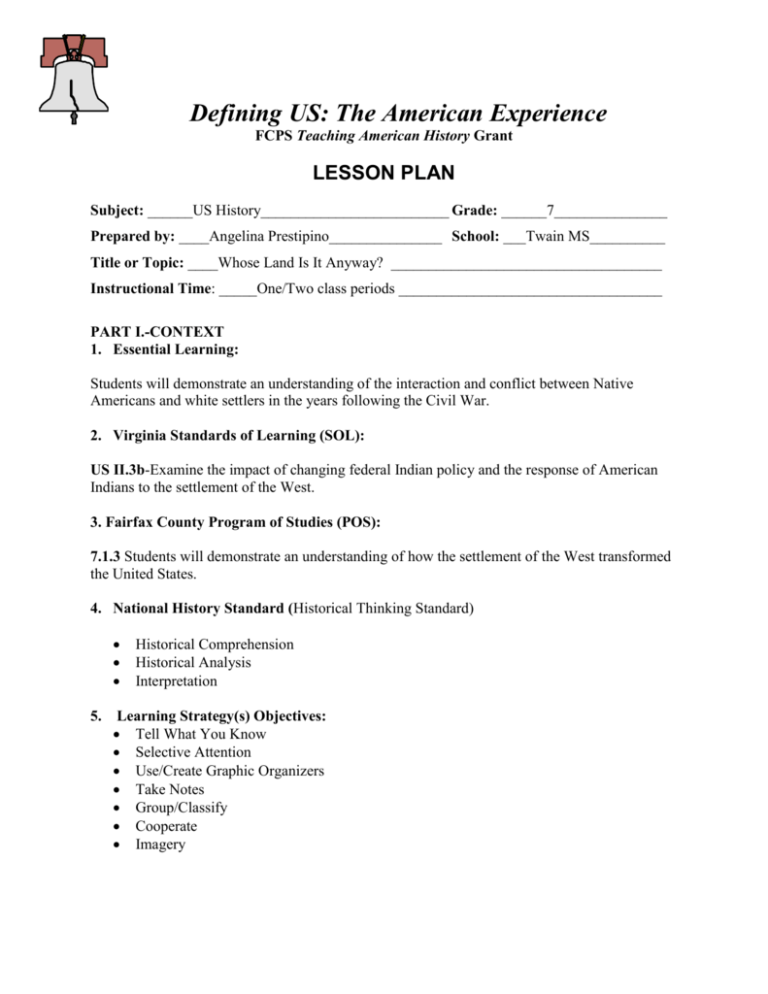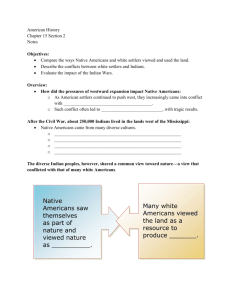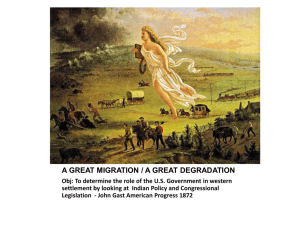Defining US: The American Experience
advertisement

Defining US: The American Experience FCPS Teaching American History Grant LESSON PLAN Subject: ______US History_________________________ Grade: ______7_______________ Prepared by: ____Angelina Prestipino_______________ School: ___Twain MS__________ Title or Topic: ____Whose Land Is It Anyway? ____________________________________ Instructional Time: _____One/Two class periods ___________________________________ PART I.-CONTEXT 1. Essential Learning: Students will demonstrate an understanding of the interaction and conflict between Native Americans and white settlers in the years following the Civil War. 2. Virginia Standards of Learning (SOL): US II.3b-Examine the impact of changing federal Indian policy and the response of American Indians to the settlement of the West. 3. Fairfax County Program of Studies (POS): 7.1.3 Students will demonstrate an understanding of how the settlement of the West transformed the United States. 4. National History Standard (Historical Thinking Standard) 5. Historical Comprehension Historical Analysis Interpretation Learning Strategy(s) Objectives: Tell What You Know Selective Attention Use/Create Graphic Organizers Take Notes Group/Classify Cooperate Imagery 6. Connection to TAH grant: Content: This lesson is a part of the history of the westward expansion in a 7th grade US history class. Information covered in this lesson was included in the NCHE colloquium in March, 2004. This lessons follows lessons that have already discussed the migration of various settlers: Manifest Destiny, homesteaders, miners, railroad workers, Exodusters, etc. Students will have already been introduced to the Lakota Indian tribe and Oklahoma Territory. The purpose of this lesson is to begin making the connections between westward expansion and the impact that it had on American Indian cultures, particularly those of the Great Plains. It should also further understanding of the Indian cultures of the Great Plains, and to begin to study the Indian Wars, treaties made with the American Indians and promises broken by the federal government as well as the policies toward American Indian populations. PART II. 1. Assessment: Food Court Story (written assignment and class discussion) Interpretation of Visuals Making Connections sheet 2. Instructional Strategies: This lesson is written for a 90 minute class period. Students will have already studied many facets of the history of westward expansion and should have a fair amount of background knowledge about the different groups of people who have settled the West up to this point in the late 19th century. 1. As students enter the classroom, the teacher should play Woody Guthrie’s song, “This Land is Your Land.” No explanation should be given about the reason the song is playing at this time. The teacher could have the lyrics printed so that they can be projected on an overhead for students who are not familiar with the lyrics. 2. Once students have been seated, the teacher could ask the students what their interpretation of the song’s meaning might be. Students may need to be prompted to understand the feeling of openness of the “land” and/or be prompted to the meaning of the “land.” The teacher can write student responses on the board. 3. Students should then be given a copy of the Food Court Story (see attachments). They should be instructed to read the story and quietly respond to it on the left side of their interactive notebooks by writing a paragraph or two about their reaction/response to the situation presented in the story. 4. Once students have completed the writing exercise, the teacher should have the students pair off and share their responses with their partners. Depending upon the group dynamics, the teacher may want to have a large group discussion and write the student responses on the board. 5. The students should then be told that the story is symbolic of events that occurred in US history between the American Indian populations and the European settlers as well as Americans moving westward during the time period they are studying. The teacher should ask the students to point out characters from the Food Court Story and explain their symbolism. 6. The teacher utilize a map of the world and review with students the path taken across the Bering Straits by the first peoples to come to the Americas thousands of years ago. It is not necessary to spend much time on this. It should only serve as a refresher to help students make the connections that the American Indians had been here prior to the arrival of the Europeans. 7. The teacher should explain that the Native Americans and the settlers had very different views about the issue of “land”. In particular, discuss how the Plains Indian’s lifestyle depended upon the movement and use of the buffalo. This clearly influenced their view of land. For settlers, landholdings were equated with wealth and prosperity. The teacher should explain that these different ways of thinking led to conflict. Before studying these conflicts, the students will examine the different views of land held by these groups. 8. The teacher can either read aloud or have students read in small groups excerpts from The Dutch Arrive on Manhattan Island: An Island Perspective (historymatters.gmu.edu). This can serve as a lead in on the perspective of the American Indians towards the white man’s view of the land and his desire to occupy it. 9. Students should be instructed to create a T-chart on the right hand side of their notebooks: one column labeled American Indian View of the Land and the other, Settlers’ View of the Land. The teacher could even dress representing the two groups as they are discussed. For example, the teacher could dress as a settler when explaining the white man’s viewpoint: “land is a symbol of wealth, it is mine to own, and the land has resources available for my use.” Indian viewpoints could include: “I believe Mother Earth should be protected and respected.” “The land belongs to all of our ancestors as well as those of use who are living.” 10. Students should take notes in the appropriate column as the teacher discusses the viewpoints. 11. The teacher should read aloud excerpts from the book, Women of the West. Excerpts in this book discuss the views of Native American and settlers regarding the use of the land and its resources. This information should supplement the different views about land. 12. The teacher should lead a discussion about the federal government’s policy to have the Indians settle in one place: the reservation system. It should be explained to the students that the government felt that the Indians were impeding the progress of a growing nation: railroads, homesteaders, ranchers, farmers and miners. Treaties were signed with American Indians giving them lands upon which they should settle and within which they should remain. These delegations of land and breaches in the contracts would lead to many disagreements causing conflicts between the groups. These conflicts resulting from these treaties would lead to battles/wars that will be discussed in upcoming classes. 13. The teacher should distribute a copy of John Gast’s picture, American Progress, 1872 (obtained from: http://www.csubak.edu/~gsantos/img0061.html) to each group. Students will already have examined this picture in the context of learning about Manifest Destiny. Students should now be asked to examine the picture in the context of the views of land. The teacher should prompt the students to think about the different groups of people in the picture. What items are they carrying with them? What does this represent? What facial expressions can they glean from the persons portrayed? What is represented by the positioning of the American Indians in the picture? 14. Students should discuss their perspectives within their small groups. One person should be the group recorder keeping track of the groups’ responses. Students should be instructed that they will share their group responses at the commencement of the next class meeting. 15. As the students are working, the teacher should distribute a Word Splash to the students to include vocabulary studies thus far related to westward expansion and the land as well as information presented during this lesson related to the views of land held by American Indians and settlers. These should include: Manifest Destiny, American Indians, Plains Indians, buffalo, reservation, private ownership, ancestral land, homesteader, Homestead Act, Great Plains, expansion, settlers, landscape, frontier, claim, desert, Lakota, Oklahoma, and Oklahoma Sooners. Their assignment should utilize the Word Splash to Make Connections with at least 10 words on the sheet. They can create five independent sentences or paragraphs with the connections they made. In total, students should use at least 10 of the terms. 16. As students are dismissed, the teacher should be at the door. As each student passes, the teacher can utter a statement that expresses either the American or Native American view of land. The students should correctly indicate which view it represents. 3. Materials/Resources to be used: Collection of Woody Guthrie’s music Copies of lyrics to “This Land is Your Land” Copies of John Gast’s picture, American Progress, 1872 Article, “The Dutch Arrive on Manhattan Island: An Indian Perspective” from http://historymatters.gmu.edu Women of the West by Bobbie Kalman and Jane Lewis Costumes if desired 4. Differentiation: This lesson was designed for special education students included in a general education classroom. It can be modified for special education classrooms by having prepared notes for students to cut and past into their notebooks or creating fill-in-the-blank notes in which the students complete. Any textual information can be copied so that students can follow along as a shared reading with the teacher. Students may need more guided instruction for completing the Making Connections activity. Students could also create illustrations making the connections. 5. Attachments: Food Court Story T-chart answers 6. Annotated Bibliography Internet Sites: http://www.pbs.org/weta/thewest This website is an excellent source for both teachers and students. It includes an interactive timeline and biographical data on persons who were part of the history of westward expansion. http://historymatters.gmu.edu/5829 This website has a variety of primary sources available that can be used for class activities, read alouds, shared and guided readings. Books: Davidson, James West and Stoff, Michael B. American Nation. Prentice Hall: 1998. This is the textbook used by general education students in the seventh grade in FCPS. This book offers information on Native American peoples of the Great Plains and ensuing conflicts. The text also includes primary resources and offers exercised in resource workbooks. Duncan, Dayton. The West: An Illustrated History For Children. Little Brown: 1996. This book is a collection of photographs of the people who settle the West. Coverage of the persons and places are not limited to the “famous” making it more realistic and giving students the opportunity to view photos not found in other books. Captions accompany many of the photos and reproductions throughout the book. Kalman, Bobbie and Lewis, Jane. Women of the West. Crabtree Publishing Company:2000. This book describes the lives and experiences of women in the 19th century American west including immigrants, African Americans and American Indians. It is part of a series titled, Life in the Old West. It has illustrations and some photographs and is a useful tool for read alouds at the middle school level. NOTE: Future lessons will discuss the promises that were broken with the American Indians. Students will utilize graphic organizers, primary sources obtainable through National Archives and the Museum of American Indian, photographs, video recordings map analysis and other class activities to further solidify their understanding of the displacement of the Native American peoples. Attachment: FOOD COURT STORY Imagine this scenario… You and your friends are at the mall. You decide to get some lunch at the food court. You all get your food and decide to sit at an empty table. As a matter of fact, the entire food court is pretty much empty except for one table. There is another group of people sitting at that table, but it appears that they have plenty of room. While you and your friends are eating, a member of the other table comes up to you and asks you to leave. You explain that there is plenty of room for everyone. The same person who has asked you to leave continues to explain that all of the tables in the food court belong to him and his group of friends and are asking you to leave. What do you do? Explain your reasons. Attachment: T-chart Answers Indian View of Land Settlers View of Land 1. land is owned by all 2. no individual boundaries or permanent cities 3. land and religion are mixed: all parts of nature have a spirit or a life and should be respected 4. belief in ancestral land 1. individual ownership of land 2. clear and/or physical boundaries 3. permanent cities 4. land and religion do not share connections 5. land is meant to be used 6. do not believe in ancestral land










